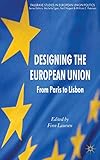Designing the European Union : from Paris to Lisbon / edited by Finn Laursen, Professor of Political Science and Canada Research Chair in European Union Studies, Director of the EU Centre of Excellence (EUCE), Dalhousie University, Halifax, Canada.
Material type: TextSeries: Palgrave studies in European Union politicsPublication details: Houndmills, Basingstoke, Hampshire ; New York : Palgrave Macmillan, [2012]Description: xv, 317 p. ; 23 cmISBN:
TextSeries: Palgrave studies in European Union politicsPublication details: Houndmills, Basingstoke, Hampshire ; New York : Palgrave Macmillan, [2012]Description: xv, 317 p. ; 23 cmISBN: - 9780230367760 (alk. paper)
- 341.242/2
- JN 30 D457 2012
| Item type | Current library | Home library | Collection | Shelving location | Call number | Vol info | Copy number | Status | Date due | Barcode |
|---|---|---|---|---|---|---|---|---|---|---|
 Libro
Libro
|
Biblioteca Juan Bosch | Biblioteca Juan Bosch | Ciencias Sociales | Ciencias Sociales (3er. Piso) | JN 30 D457 2012 (Browse shelf(Opens below)) | 1 | 1 | Available | 00000113218 |
Includes bibliographical (pages 283-307) references and index.
Introduction : on the study of EU treaties and treaty reforms -- The European Coal and Steel Community (ECSC) and European Defence Community (EDC) -- All roads lead to Rome : background, content and legacy of the treaties on the European Economic and European Atomic Energy communities -- The 1965 Merger treaty : the first reform of the founding European Community Treaties -- The 1970 and 1975 Budget treaties : enhancing the democratic architecture of the community -- The Single European Act : revitalising european integration -- The treaty of Maastricht : designing the European Union -- The Amsterdam treaty : modest reforms -- The treaty of Nice : the inadequate preparation -- The Constitutional treaty : the failed formal constitutionalisation -- The treaty of Lisbon : constitutional treaty, episode II -- Conclusions : so what do we know about EU treaties and their reforms? And where may we be going?
This book has chapters on all the treaties establishing the European Communities in the 1950s as well as subsequent treaties reforming these community treaties (Merger Treaty, Budget Treaties, and the Single European Act) followed by chapters on the Maastricht Treaty establishing the European Union in 1993 and subsequent amendments thereof through the Amsterdam, Nice and Lisbon treaties. The authors are all established and well-known scholars of European integration. The book thus traces the 'constitutional' foundation of the European Union (EU) over time and analyses these development from a comparative perspective: who were the main actors, what were their preferences and which institutions did they design to deal with common problems and challenges? Despite the rejection of the proposed Constitutional Treaty in referendums in France and the Netherlands in 2005 the 'constitutionalization' of the EU has continued. The book tries to answer both the 'how' and 'why' questions of this fascinating process.


There are no comments on this title.